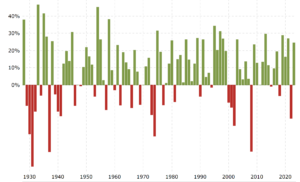Another year has wrapped up. For professional investors, December 31 means the final calculation of total return for the year. That number goes into the record books, Morningstar’s database, and countless Powerpoint presentations. It is compared to prior-year results, and to those of benchmarks. Peer ranks are established, plaudits announced, and bonuses determined. The investment clock resets on January 1st, and we start the process anew, trying to achieve superior outcomes for another twelve months.
But why do we measure the end of one year and the beginning of the next on these dates? It turns out to be completely arbitrary. You can look up it. The answer involves Julius Caesar and the early history of Christianity. And it shouldn’t come as a surprise that the timing is close to the winter solstice, a natural point—perhaps the most natural—to mark the earth’s latest revolution around the sun. Hundreds of paleo-lithic monuments around the world, such as Stonehenge in England, were constructed to observe the shortest day of the year precisely.
You’ll read as well that other religious dates, many near the spring equinox, have been used by various societies as the start of a year. It is only in the early modern period that Western society settled on January 1. (Julius Caesar’s original version—the Julian calendar—had flaws in it and was corrected by Pope Gregory XIII in 1582 in the form of the Gregorian calendar we currently use.)
But the choice of a particular month or day is subjective. There is nothing inherently meaningful from an investment perspective about December 31. For instance, businesses do not necessarily return their capital to investors on that or any other day, having summed up their returns from voyages to the East.
Closer to home, the US stock market is open 250 days per year. You could use either solstice or either equinox to start the annual measurement period. The famous Buttonwood Agreement, creating what would become the New York Stock Exchange, was signed on May 17, 1792. Why not have a sunny spring day to start the investment year? Or the specific day in August of 1602 when the shares of the Dutch East India company began trading on the Amsterdam Stock Exchange?
The last day of the year may not matter much. But having a particular day does. It generates a measurement system that is based on a snapshot in time. What are my assets at that time, on December 31st? How does it compare to my assets at some prior period, especially 12-months ago?
Contrast that with the approach of the dividend investor, who links the value of an asset not necessarily to the market price on any given day, but to its income generating ability over time. Or to quote Irving Fisher, “the stock of wealth is called capital, and its stream of services is called income. The income is the more important concept of the two, for the capital exists merely for the sake of the income, and the ownership of the capital has no other significance than the ownership of possible income from that capital.” Yes, income can be and should be counted annually, and December 31 is as good as any other date to do so, but that is a matter of convenience, not principle.
Moreover, dividend investors in the stock market can’t help but observe that while asset prices reset daily and sometimes wildly, a portfolio of income streams has much smaller variances. As a result of the market’s focus on asset prices rather than income streams, the arbitrary annual measurement of total return risks putting the cart before the horse, conflating the importance of capital and income. The income approach is not based on what you have in the bank on the final day of the measurement period, but on what those assets generate in consumable (or re-investable) income over time.
The topic is taken up in greater detail in Chapter 5 of Getting Back to Business from 2018, and in Chapter 8 of the forthcoming Ownership Dividend. In the meantime, Happy New Year. I wish stock investors a satisfying December 31 tallying up of their assets. And to dividend investors and business owners, I wish them continued success in generating a high-and-rising income stream from their assets. To each their own.
